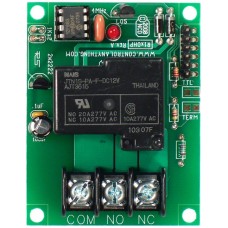RS-232 1-Channel High-Power Relay Controller LOW COST
RS-232 Serial Relay Controller
Our RS-232 Relay Boards are fully E3C complaint, allowing up to 256 NCD devices to share a single RS-232 serial port. Mix and match up to 256 devices in any combination. Speak to each device individually or all devices at once. To control the this Relay Controller, simply connect a data and ground wire between the Relay Controller and computer or microcontroller. Provide +12 Volts DC to the board, and send ASCII character codes to control the relays. Even a no-frills design deserves a high-quality driver stage, and that’s exactly what we put on our Serial Relay Controllers. Fast-reacting flyback diodes help shunt dangerous voltages away from the driver circuit.
Features include no-click startup, LED status lights, and E3C compliance. Relays can be controlled at 9600 baud and the board is compatible with ANY computer or microcontroller capable of delivering RS-232 data.
20-Amp SPDT Relay Option
This controller is available with a 20-Amp relay option, allowing control of high-power loads up to an absolute maximum of 240VAC at 20 Amps. Ideal for high-power switching applications, this relay should never be used for low-power signals. The 20-Amp relay is of the SPDT variety, which provides Common (C), Normally Open (NO), and Normally Closed (NC) connections. Common is connected to NC when the relay is off. Common disconnects from NC and connects to NO when the relay is activated. This relay uses .250″ Quick Connect terminals (optional accessory) to connect to the top side of the relay. The relay is molded with COM, NC, and NO markings into the plastic.
30-Amp SPST Relay Option
This controller is available with a 30-Amp relay option, allowing control of high-power loads up to an absolute maximum of 240VAC at 30 Amps. Ideal for high-power switching applications, this relay should never be used for low-power signals. The 30-Amp relay is of the SPST variety, which provides Common (C) and Normally Open (NO) connections. Common has no connection when the relay is off. Common connects to NO when the relay is activated. This relay uses .250″ Quick Connect terminals (optional accessory) to connect to the top side of the relay. The relay is molded with COM, NO markings into the plastic.
Features
- 9600 Baud Operation
- Relay Status LEDs
- Quick Connect Terminal Blocks
- TTL RS-232 Inputs
- +12 Volt Operation, 2-Wire RS-232
- Overkill Transistor Drivers
- No-Click Power-up
- 2-Way Communication Capable
Enter the code in the box below:

-74x74.jpeg)

